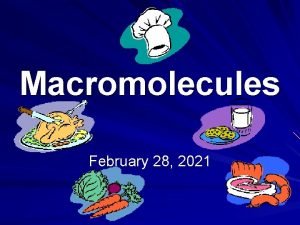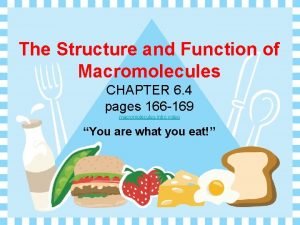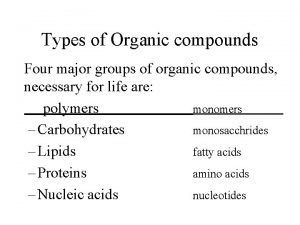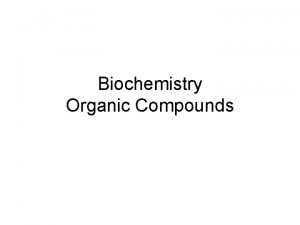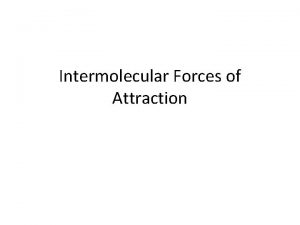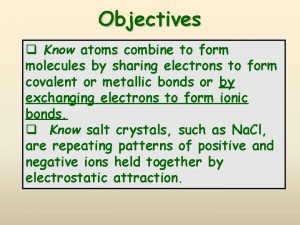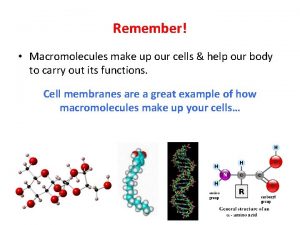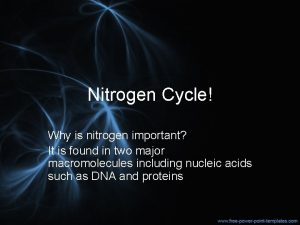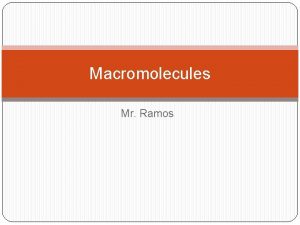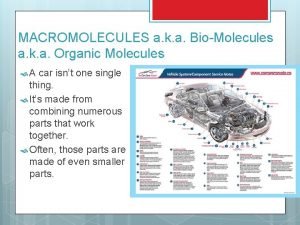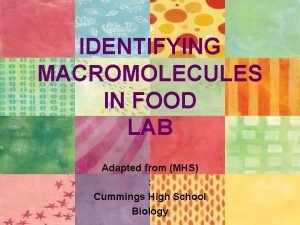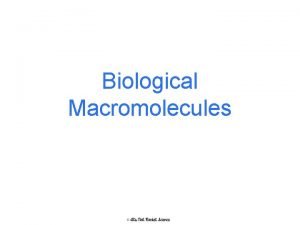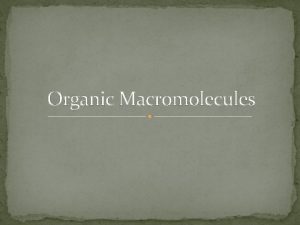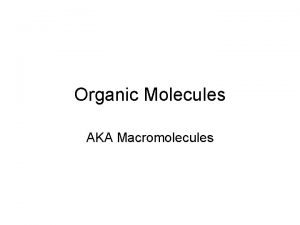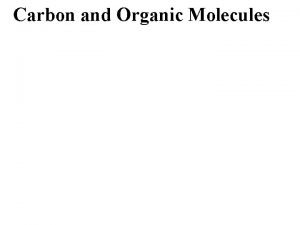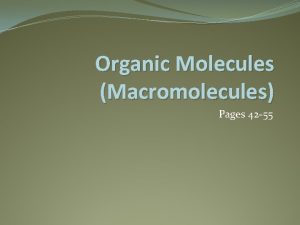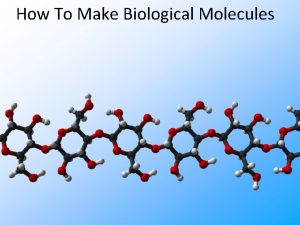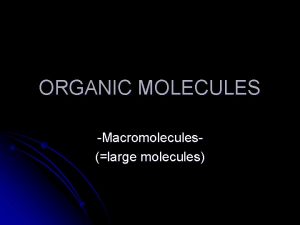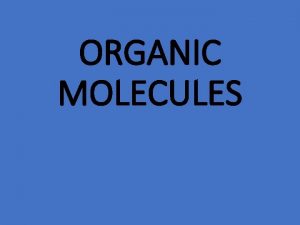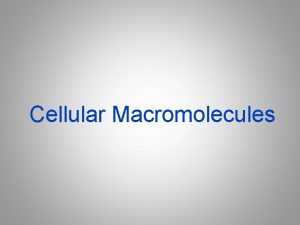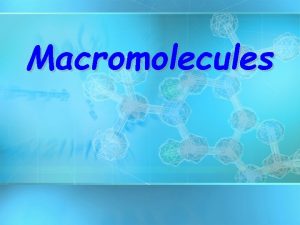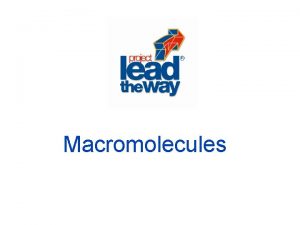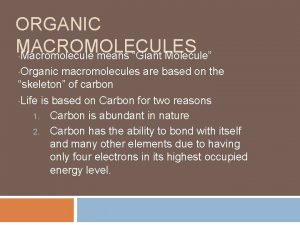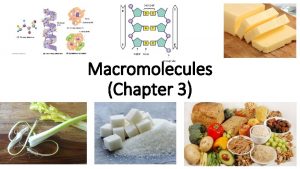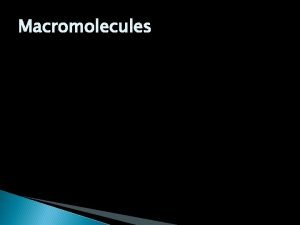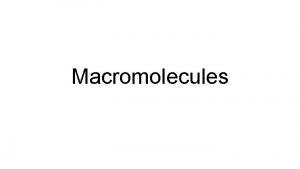Macromolecules Smaller organic molecules join together to form





















- Slides: 21

Macromolecules § Smaller organic molecules join together to form larger molecules u macromolecules § 4 major classes of macromolecules: carbohydrates u lipids u proteins u nucleic acids u AP Biology

Polymers § Long molecules built by linking repeating building blocks in a chain u monomers § building blocks § repeated small units u H 2 O covalent bonds HO H Dehydration synthesis AP Biology HO H

How to build a polymer § Synthesis u You gotta be open to “bonding”! joins monomers by “taking” H 2 O out § one monomer donates OH– § other monomer donates H+ § together these form H 2 O u H 2 O requires energy & enzymes HO H enzyme Dehydration synthesis Condensation reaction AP Biology HO H

How to break down a polymer Breaking up is hard to do! § Digestion u use H 2 O to breakdown polymers § reverse of dehydration synthesis § cleave off one monomer at a time § H 2 O is split into H+ and OH– w H+ & OH– attach to ends requires enzymes HO u releases energy H 2 O u enzyme H Hydrolysis AP Biology Digestion HO H

Carbohydrates AP Biology

CH 2 OH H HO O H OH Carbohydrates energy molecules AP Biology 2006 -2007

Carbohydrates § Carbohydrates are composed of C, H, O carbo - hydr - ate CH 2 O (CH 22 O) O)xx C 66 H 12 O (CH 12 66 § Function: energy u raw materials u energy storage u structural materials u § Monomer: sugars § ex: sugars, starches, cellulose AP Biology sugar sugar

Sugars § Most names for sugars end in -ose § Classified by number of carbons 6 C = hexose (glucose) u 5 C = pentose (ribose) u 3 C = triose (glyceraldehyde) u CH 2 OH H HO O H OH H AP Biology 6 H OH Glucose H CH 2 OH OH C O H HO H 5 OH O HO H Ribose H H C OH 3 OH H Glyceraldehyde

Functional groups determine function carbonyl aldehyde carbonyl ketone AP Biology

Sugar structure 5 C & 6 C sugars form rings in solution Where do you find solutions in biology? In cells! AP Biology Carbons are numbered

Numbered carbons C 6' 5' C O C 4' C 1' energy stored in C-C bonds C 3' AP Biology C 2'

Simple & complex sugars § Monosaccharides simple 1 monomer sugars u glucose u § Disaccharides 2 monomers u sucrose u § Polysaccharides large polymers u starch u AP Biology CH 2 OH H HO O H OH H H OH Glucose H OH

Building sugars § Dehydration synthesis monosaccharides | glucose AP Biology H 2 O | glucose disaccharide | maltose glycosidic linkage

Building sugars § Dehydration synthesis monosaccharides disaccharide H 2 O | sucrose (table sugar) | glucose AP Biology | fructose Let’s go to the videotape!

Polysaccharides § Polymers of sugars costs little energy to build u easily reversible = release energy u § Function: u energy storage § starch (plants) § glycogen (animals) w in liver & muscles u structure § cellulose (plants) § chitin (arthropods & fungi) AP Biology

Linear vs. branched polysaccharides slow release starch (plant) energy storage What does branching do? glycogen (animal) AP Biology fast release Let’s go to the videotape!

Polysaccharide diversity § Molecular structure determines function in starch in cellulose isomers of glucose u structure determines function… u AP Biology

Digesting starch vs. cellulose starch easy to digest enzyme cellulose hard to digest enzyme AP Biology

Cellulose § Most abundant organic compound on Earth herbivores have evolved a mechanism to digest cellulose u most carnivores have not u § that’s why they eat meat to get their energy & nutrients § cellulose = undigestible roughage AP Biology But it tastes like hay! Who can live on this stuff? !

Cow can digest cellulose well; no need to eat other sugars Gorilla can’t digest cellulose well; must add another sugar source, like fruit to diet Regents Biology

Helpful bacteria § How can herbivores digest cellulose so well? u BACTERIA live in their digestive systems & help digest cellulose-rich (grass) meals Caprophage Ruminants Regents Biology Tell Ime about eat the rabbits, WHAT! again, George!
 Organic molecules vs inorganic molecules
Organic molecules vs inorganic molecules Organic macromolecules chart
Organic macromolecules chart What is this?
What is this? The four major groups of organic compounds are
The four major groups of organic compounds are Organic vs inorganic molecules
Organic vs inorganic molecules Four types of organic molecules
Four types of organic molecules Density of air
Density of air Molecule ion attractions are found in
Molecule ion attractions are found in What holds molecules together?
What holds molecules together? Prayer join hands
Prayer join hands Opvoedbelasting
Opvoedbelasting Atoms combine to form
Atoms combine to form Noun form of join
Noun form of join Macromolecules
Macromolecules Macromolecules with nitrogen
Macromolecules with nitrogen Macromolecules
Macromolecules What are macromolecules
What are macromolecules Macromolecules
Macromolecules Cholesterol hydrophobic or hydrophilic
Cholesterol hydrophobic or hydrophilic Macromolecule indicator tests
Macromolecule indicator tests Micromolecules and macromolecules
Micromolecules and macromolecules What are macromolecules
What are macromolecules

